Švejk took over the masses. Almost a hundred years after its release, it still entertains, touches and ignites emotions. It is sometimes forgotten that the life story of Jaroslav Hašek is, above all, an excellent compendium of knowledge about the First World War and a meticulous documentation of the fall of the Austro-Hungarian monarchy.
"The fate of the good soldier Švejk during the world war" is a real road novel, set in a specific time and place. Although it belongs to fiction, it can be treated almost like a reportage. This is evidenced by the author's biography, who made the protagonist of his novel wander along the paths he had trodden.
Švejk's military journey in the footsteps of Hašek
We know from the biography of Hašek by Radko Pytlik that “[Hašek] reacted in a peculiar way to the news about the incorporation into the 91st infantry regiment in České Budějovice. He shut himself up in a room and sang soldiers' songs all evening. It was in this regiment that Švejk himself experienced his peculiar adventures.
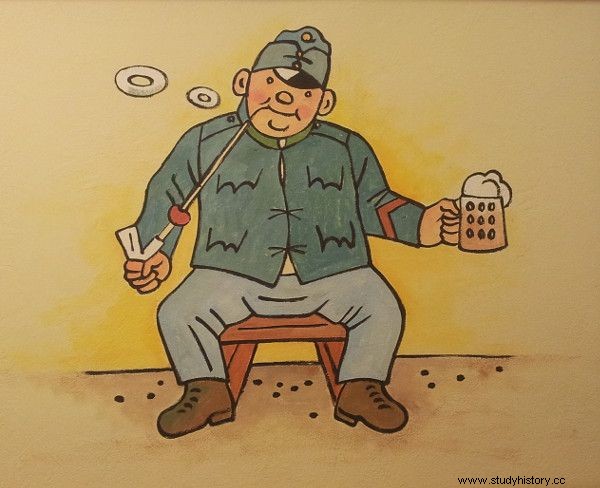
Hašek in the mask of Švejk? (photo:Jirka.h23, CC BY-SA 4.0)
When Jaroslav Hašek has already got used to C.K. uniform, he ended up in Bruck on Lithuania, a border town. On the Hungarian side of the river was Kiralyhid, a place well known to Švejk. It was there that Lieutenant Lukasz got into a moral scandal with the townswoman Etelka Kakonyi. In Kiralyhid, the reader also meets the sapper Wodiczko, a friend of Švejk, and the famous Magyar Eater. After a short stay in the border town, Jaroslav Hašek and the hero he created went to the front. As Pytlik writes:
On the front lines, Hašek begins to play the role of a naive, goofy soldier. Sam puts on Švejk's mask to be able to boycott the commander's orders.
At some point, however, the paths of Hašek and Švejk diverge irretrievably. The protagonist of the novel travels with the regiment to eastern Galicia. On the other hand, Hašek on November 24, 1915, during a night attack by the enemy with a group of soldiers, "lays down their weapons and waits in the trenches until the Russians take them captive."
Most of the Schweikologists have no doubts that the fates of Hašek and Švejk were to be intertwined more than once. The author's death, who left the orphaned Švejk in some East Galician hole, stood in the way. As for the future of the happy soldier, one can only speculate. Just like Antoni Kroh in the pages of his excellent book "About Švejk and about us":"What if (Szwejk) joined the Red Army and fought against the Legions, like Hašek? Maybe he would become an agitator, a political worker? ”.
The analogies between the fate of the author and the protagonist of the novel indicate one thing:Hašek was often an eyewitness to the events described in the book. It can certainly be treated as a kind of document of these interesting times.
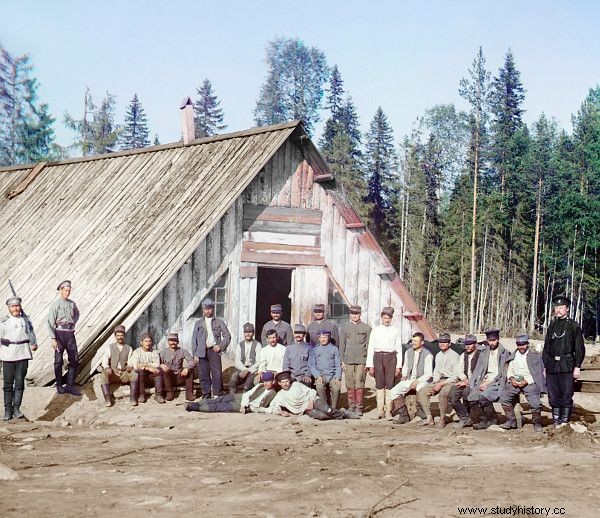
Švejk, unlike Hašek, did not end up in a Russian prisoner of war camp
How many Hašek in Švejk?
Did Hašek portray himself while creating the figure of Švejk? This conclusion can be reached through the physical similarity of the two characters. One can take a closer look at the author's photos and compare them with the image of Švejk, portrayed by the cartoonist and friend of Hašek, Josef Lada. They are both tall, well-established, sometimes innocent cherubs, and sometimes poured drunks.
The author and the protagonist of his novel are also linked by biographical threads - both gentlemen were involved in dog trade before the war, they also had an episode in a hospital in České Budějovice. The aforementioned threads, external appearance, tendencies to hang out in pubs and a coarse lifestyle are the only similarities between Hašek and Szwejk.
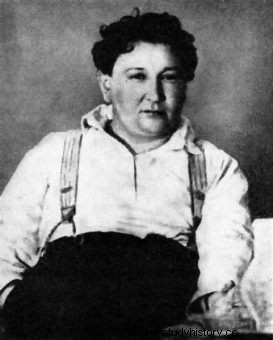
Tęgi with the face of an innocent but poured cherub:and Hašek, and Szwejk
As Radko Pytlik explains:
The legend circulating about Hašek tried to imply that he was an ignorant man (...). The trade school certificate clearly contradicts this. (...) Hašek learned not only German, Russian, Latin, but also Hungarian, Bulgarian, even a little Polish .
Many of Hašek's former acquaintances confirmed that under the mask of a jester there was a sensitive person, gifted with an outstanding mind and, above all, memory. The author of Szwejk is also an uncompromising idealist, a man with clear, sharp views on reality.
Hašek himself can be found in the pages of the novel in a completely different form. According to the biographer, "Marek's one-year-old volunteer from the novel is largely (...) a discreet self-portrait" of the writer. This is indicated both by the intellectual and mockery nature of the hero, the title of a one-year-old volunteer and writer of the battalion, and the past - that is, a work in the magazine "Świat Animal".
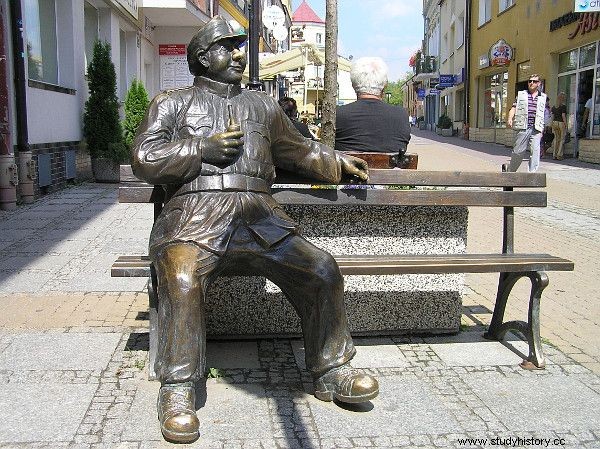
Everyone wants to warm up in the splendor of Švejk's fame. Here is a bench in Sanok (photo:Beentree, CC BY-SA 3.0)
Švejk and history
As a pre-war anarchist and pacifist, Jaroslav Hašek had an unequivocally negative attitude towards power, politicians and the army. Thus, important historical events from the First World War are intentionally trivialized by the author of the epic. The writer, on the other hand, highlights the fate of the gray man involved in this war adventure. Although he has a disrespectful attitude towards events of state importance, they nevertheless find their place in the pages of the novel. Here are the two most expressive examples:
Assassination of Prince Ferdinand (June 28, 1914)
Hašek's work begins with the famous sentence:"And this is what they killed Ferdinand for." Szwejk associates the slogan "Ferdinand" only with two characters:Ferdinand, a servant who accidentally drank a hair-growing ointment, and Ferdinand, a collector of dog shit. When she finally finds out that the word is "fat, godly", she wonders if the bomber was dressed up, and concludes that a fat victim is much easier to hit.
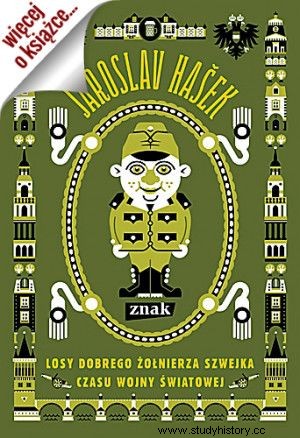
"The Fate of the Good Soldier Švejk" is not only an excellent novel, but also a document of the extraordinary times of the First World War.
The betrayal of an Italian ally (May 23, 1915)
Information about Italy's transition to the Entente's side found soldiers of the 91st Regiment in Budapest. On the news of his ally's betrayal, Švejk told a long story of a shopkeeper Poszmurny, who was deceived and betrayed by the merchant Havlasa.
World War I in a nutshell
By creating "The Fate of the Good Soldier of World War I," Jaroslav Hašek became, by the way, a history teacher for generations of readers. A very subjective teacher, revealing the handicap of a crumbling monarchy, stigmatizing the stupidity and tragedy of war.
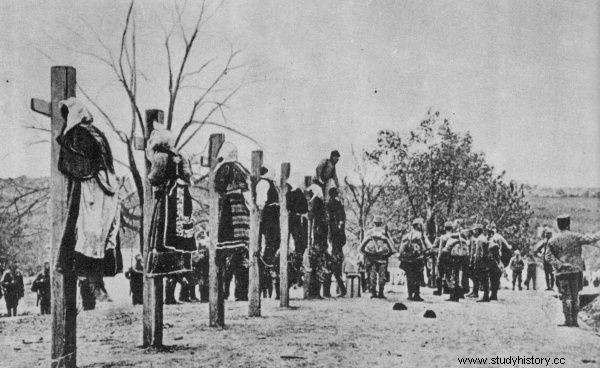
Jaroslav Hašek had an unequivocal opinion about the atrocities of the war.
Hašek is also an effective teacher, as he used the most attractive pedagogical methods:he persuaded his arguments by mocking, mocking, mocking. Hašek's novel, devoted to the realities of the Eastern Front of World War I, is a natural complement to the famous work by Erich Maria Remarque, "No Change in the West". Both works, although different in character, best describe the tragedy of that war.
***
On the occasion of the 100th anniversary of Jaroslav Hašek's appointment to the army, Znak publishing house resumed its translation " The fate of the good soldier of World War I," in a new translation by Antoni Kroh. It was first published in 2009 and is significantly improved compared to the old translation by Paweł Hulka-Laskowski from 1931. As a reader of "Historical Curiosities" you can buy this book at a 30% discount!
Bibliography
- Radko Pytlik, Jaroslav Hašek, Československý spalovatel , 1962
- Antoni Kroh, About Szwejk and us , Sądecka Publishing House, Nowy Sącz 1992.
- Jaroslav Hašek, The fate of the good soldier Švejk during the World War , crowd. A. Kroh, SIW Znak, Krakow 2015.
- Same, Osudy dobrého vojáka Švejka za světové války , Knižní klub, Prague 2008.
Editor:Roman Sidorski, Photoedition:Roman Sidorski
